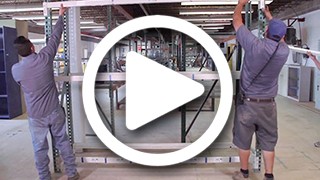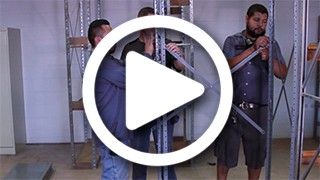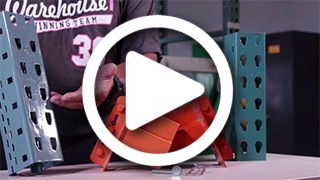Pallet Rack Storage Ideas for Warehouses
An optimized warehouse makes life easier for employees and customers alike. Unfortunately, cluttered and chaotic workspaces are common. Problematic pallet racking is often to blame, as are unclear or insufficient labels. With a few modest adjustments, however, it's possible to revitalize an otherwise dysfunctional warehouse environment.
The Importance of Efficient Warehouse Pallet Storage
Efficient pallet storage is vital for modern warehousing, impacting cost savings and scalability. It's about more than just pallet rack organization; it's about optimizing the warehouse environment for peak performance. This not only reduces operational costs by using space more effectively but also enables businesses to easily scale operations to meet market demands.
Maximum storage density is always the goal, but it should not come at the cost of efficient retrieval or worker safety. Today's most creative pallet racking solutions provide the best of both worlds: exceptional efficiency and high volume storage.
The goal is to make the most of every minute and square foot. Efficient warehouse storage leads to quicker order fulfillment, enhancing customer satisfaction, and ensures a safer workplace, aligning with regulatory standards. Ultimately, focusing on efficient pallet storage boosts productivity and profitability.
Below, we go over the different benefits of improving your storage system, and ideas on how to do so.
Key Benefits of Optimizing Pallet Rack Storage
 Strong warehouse organization is absolutely critical in today's competitive market. There is no room for error or inefficiency in your enterprise's workflow. Even modest adjustments to your pallet storage setup could deliver huge cost savings and productivity improvements. Key benefits worth considering include:
Strong warehouse organization is absolutely critical in today's competitive market. There is no room for error or inefficiency in your enterprise's workflow. Even modest adjustments to your pallet storage setup could deliver huge cost savings and productivity improvements. Key benefits worth considering include:
Increased Storage Density
Given the rise of micro fulfillment and general increases in operational costs, it should come as no surprise that business leaders feel pressed to do more with less. If storage density can be improved, there's no need to pay for larger, less efficient spaces.
Facilities with exceptional storage density also tend to be more scalable; while this usable space may not always be required, it makes it possible to handle sudden spikes in demand with ease.
Decreased Order Fulfillment Times
Immediate access to inventory is crucial in an age of heightened customer demands. Not only does faster order fulfillment lead to greater customer satisfaction, but the strategic inventory management required to achieve this expedited pace also limits time and labor costs.
Keep Workers Safe
Improvements to density and efficiency should not come at the cost of worker safety. All pallet rack storage ideas must emphasize employee protection. Often, improvements aimed to increase productivity have the positive accompanying effect of boosting workers' long-term health and safety. For example, automated solutions such as pallet shuttles limit the need for heavy lifting or dealing with heights.
Selecting the right pallet rack style, including teardrop, structural, Ridg-U-Rak, selective, drive-in/drive-through, push-back, or pallet flow racks, plays a pivotal role in determining your storage strategy. Each style offers unique benefits regarding density, accessibility, and inventory management, emphasizing the importance of choosing a rack type that aligns with your warehouse's specific operational requirements and objectives.
6 Pallet Rack Storage Ideas to Increase Efficiency
There is no universal solution for pallet storage. A variety of factors must be taken into account; it helps to examine different pallet racking ideas before narrowing your options based on the situation at hand.
Consider implementing these pallet rack ideas to make your warehouse or distribution center safer and more efficient.
1. Add Vertical Space
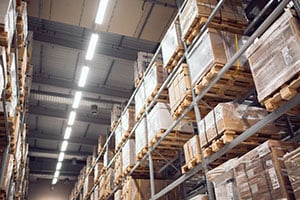 Warehouses can only obtain so much square footage, but vertical space often goes unused. Perhaps it's time to ditch the single uprights and add extra levels to the mix.
Warehouses can only obtain so much square footage, but vertical space often goes unused. Perhaps it's time to ditch the single uprights and add extra levels to the mix.
The easiest solution? Stacking pallets vertically. This is a wonderful option for storing larger items while also freeing up valuable floor space. Of course, the decisions don't end there. Many types of pallet racks exist, so you'll need to choose the right setup for your facility. Top racking systems include:
- Selective pallet racking. Featuring single-deep rows with several levels, selective systems are ideal for high-SKU operations, especially when FIFO (first in, first out) is required.
- Teardrop pallet racking. Renowned for its ease of assembly and flexibility, teardrop racking features a universal design that allows for quick adjustments. This system is ideal for warehouses that frequently adjust shelf heights to accommodate different pallet sizes.
- Structural style pallet racking. Known for its durability and strength, structural racking is constructed from hot-rolled steel. It's particularly suited for warehouses with heavy loads or in environments where a robust system is necessary due to high traffic or the use of heavy equipment.
- Ridg-U-Rak style pallet racking. This versatile racking solution offers a range of configurations, including selective, drive-in/drive-through, and push-back options. Ridg-U-Rak is customizable to fit specific storage needs, making it a great choice for optimizing space efficiency and operational flow.
- Drive-in and drive-through pallet racks. If items don't need to be moved as quickly, drive-in pallet racks may optimize storage space for LIFO (last in, first out) solutions. With this system, forklifts are limited to one side. Drive-through options are preferred when high utilization rates are necessary. They work best for FILO (first in, last out) inventory that needs to move quickly. Under this approach, forklifts load on one side and unload on the other.
- Push-back pallet racks. High-density push-back racks offer single-lane selectivity for faster picking. This is a great middle-ground solution for those unwilling to compromise on either volume or efficiency.
- Pallet flow racks. Pallets are loaded in the back of the system and then flow to the front for picking, pallet flow racks are ideal for FIFO inventory where there are a smaller number of high-volume SKUs.
By considering these and other racking systems, you can tailor your vertical expansion to the specific demands and dynamics of your warehouse. Adding freestanding mezzanines and catwalks, or exploring cantilever racks for non-palletized items, further enhances capacity and flexibility, ensuring every square foot is utilized to its maximum potential.
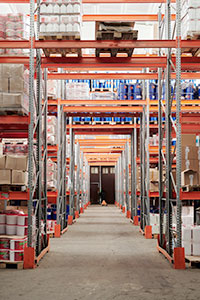 2. Clear Aisles
2. Clear Aisles
Inventory should never block aisles. Not only does this constitute a huge safety hazard, but it also limits warehouse productivity. Labeling promotes clear aisles by providing visual cues regarding the flow of traffic and the proper spaces in which items should actually be kept. Highlight fixed spaces in which major assets can be stored — and use a high-density industrial pallet racking system to handle inventory.
3. Sort Orders
Items stored in your warehouse should be categorized according to sales volume. The most popular items will ideally be the most accessible, as this will reduce retrieval time.
When in doubt, turn to the ABC Analysis of Inventory as a warehouse management blueprint for profiling your orders. This incorporates three distinct categories:
- A: Bestsellers that take up limited space
- B: Mid-range items that are typically bulkier than products in category A.
- C: The remainder of your inventory, including the largest items with the least impressive sales figures.
Keep in mind that products firmly found in category A during one season may shift to category B or C later on. Be prepared to adjust categories and locations according to seasonal shifts in demand.
4. Change Layout
 Evaluating your current layout for opportunities to integrate more efficient racking solutions can transform warehouse operations. If your warehouse's pallet racking layout limits efficiency or storage capacity, what's keeping you from making strategic changes? A different layout could transform how your warehouse operates. Consider how different racking styles could enhance or hinder workflow and adjust accordingly.
Evaluating your current layout for opportunities to integrate more efficient racking solutions can transform warehouse operations. If your warehouse's pallet racking layout limits efficiency or storage capacity, what's keeping you from making strategic changes? A different layout could transform how your warehouse operates. Consider how different racking styles could enhance or hinder workflow and adjust accordingly.
As you develop a new, more targeted floor plan, pay close attention to your workflow. The goal should be to avoid crossover whenever possible. This is only possible if all areas are clearly defined. As mentioned previously, this is best accomplished with a strategic labeling system.
The experts at WH1 can help with your layout design needs.
5. Remove Bottlenecks
Traffic jams should never exist within the warehouse environment, and yet, such hold ups are all too common. Known as bottlenecks, these situations involve sudden and significant delays to an otherwise streamlined warehouse process flow.
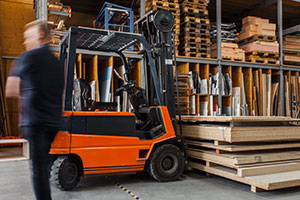 Even if the rest of the warehouse operates at maximum efficiency, bottlenecks will impede productivity until they're resolved.
Even if the rest of the warehouse operates at maximum efficiency, bottlenecks will impede productivity until they're resolved.
Bottlenecks are common, but not inevitable. Audit your operation to determine where they exist and whether any of the previously mentioned warehouse solutions could be helpful for resolving them.
Often, they result from poor labeling or excessive crossover traffic — so once you address these problems, you may find that major holdups become a thing of the past. Other common issues worth fixing include:
- Improper allocation of workers to high-need tasks
- Outdated or poorly maintained equipment
- Poor lines of communication
- Unreliable WiFi connection
Bottlenecks may also occur if your pallet racking system or general warehouse design is not chosen according to your specific material handling needs. For example, if high selectivity is required but you choose a system that prioritizes high density, bottlenecks are all but guaranteed.
6. Efficiently Receive Inventory
An effective workflow should free up valuable space for receiving inventory. Often, however, receiving is a cumbersome process filled with delays and miscounted items. Many large-scale accuracy concerns involve receiving, so it's extra important to optimize this process.
Effective receiving starts with a reasonably spacious dock, where workers can operate more effectively. Free up space by using strategic pallet solutions elsewhere in your facility. Many of the pallet storage ideas mentioned previously should eliminate blockages and expand much-needed dock space.
Add real-time tracking to the mix to provide greater insight into the receiving process. Through careful tracking, you can determine early on whether miscounts or other errors have occurred. These can then be fixed quickly, before they lead to bigger problems. By leveraging the right pallet-racking solutions, you can create a more organized, accessible space for incoming goods.
Additional Warehouse Pallet Storage Considerations
When refining your warehouse pallet storage strategy, it's essential to consider additional factors that go beyond basic organization and capacity—each playing a crucial role in optimizing your operations for efficiency, safety, and scalability.
- Technological Integration in Pallet Storage: Innovations such as Automated Storage and Retrieval Systems (AS/RS), Vertical Lift Modules (VLMs), and automated pallet shuttle systems boost efficiency, accuracy, and safety, fostering a proactive, agile, and data-driven warehouse environment.
- Regulatory Compliance and Safety Standards: Essential for safety and legal compliance, understanding OSHA and NFPA regulations specific to pallet storage protects workers and prevents legal issues.
- Sustainability Considerations: Efficient warehouse storage reduces energy use and waste, contributing to sustainability by reusing or recycling pallets and optimizing operations.
- Customization and Consultation: Tailored pallet storage solutions, advised by our experts, enhance efficiency and productivity, meeting the unique needs of your warehouse.
Transform Your Pallet Rack Setup With Help From Warehouse1
If the pallet rack storage systems highlighted above are any indication, customized solutions are essential for streamlining your warehouse. The wrong approach could lead to costly errors and inefficiencies.
Changing up your warehouse layout or workflow may seem intimidating, but you don't have to go at it alone. At Warehouse1, we're happy to provide the insight and guidance you need. Contact us today to learn more about our warehouse pallet racking solutions.
